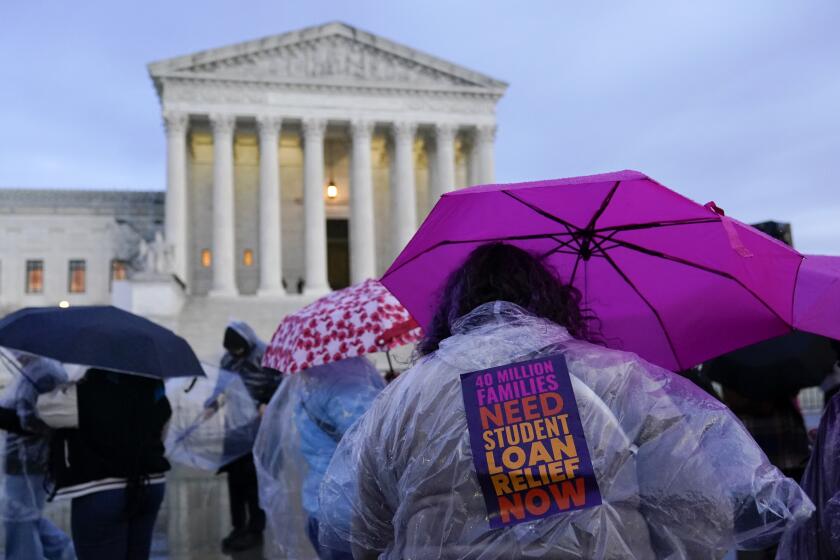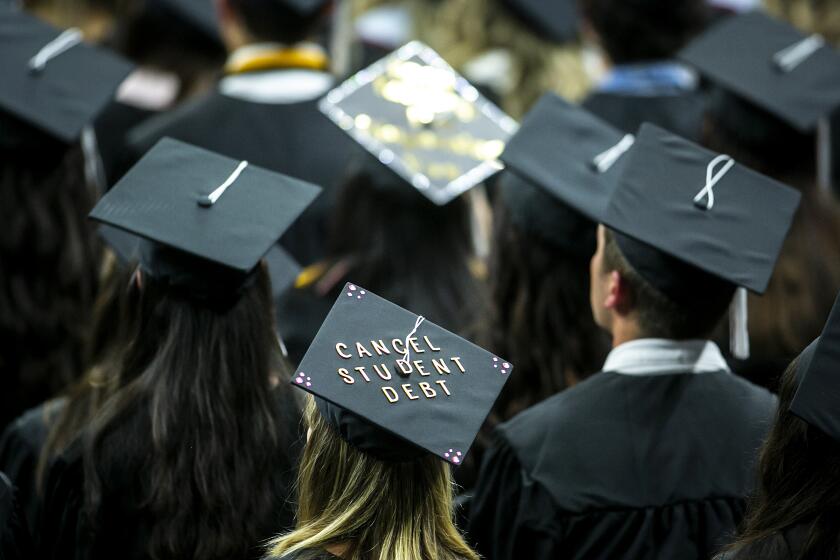Now that student loan payments are back, here are 5 options if you’re crushed by debt

- Share via
The return of federal student loan payments this month has the potential to derail your finances, especially if you’re already struggling with credit card payments.
One in 5 student loan borrowers have risk factors that suggest they could struggle with student loan payments when they resume, according to the Consumer Financial Protection Bureau.
The impact won’t be as significant during the initial 12-month student loan onramp period from Oct. 1 to Sept 30, 2024. You won’t default on student loans or see credit scores plummet after missing payments during that time.
But interest will continue to accrue, making the growing debt more difficult to manage. Use the next 12 months to make progress with consistent payments. You’ll save more money over time and pay down debt faster.
Here are some strategies to consider as you’re getting started.
The 50/30/20 budget was popularized by Sen. Elizabeth Warren and her daughter Amelia Warren Tyagi in their book, “All Your Worth: The Ultimate Lifetime Money Plan.”
Revamp your budget
An updated budget clarifies how much money is available to pay down debts. Review your debit and credit card statements for opportunities to cut back or find cheaper alternatives.
Start by writing down where your money is going, said Kristen Holt, chief executive of GreenPath, a nonprofit credit counseling organization.
Prioritize essentials such as rent, utilities and transportation, she said. Work toward building an emergency fund of at least $500 to prevent more debt.
“Even if you’re putting $10 a paycheck into a savings account, it takes a while, but it’s still going to be better than zero,” Holt said.
Next, determine whether you’ll be laser focused on student loan or credit card debt. Keep up with all payments, but put more money toward the high interest debt to make more progress. Credit cards typically have higher interest rates unless new terms are applied through an agreement or promotional offer.
Federal student loan payments resume this month. Here’s how you can locate your account information, get payment details and find repayment plan options available to you.
Seek lower credit card interest rates
A good credit score of 690 or higher can qualify you for low-interest offers. A balance transfer credit card, for instance, lets you move debt from a different account onto the card to get a lower interest rate.
The ideal balance transfer card has no annual fee, a 0% introductory interest rate and a reasonable balance transfer fee of 3% or lower. If that fee is lower than your current projected interest payments, the savings will add up and you can apply them to student loan payments.
For multiple credit card balances, consider a personal loan that consolidates debts into a single low-interest fixed payment.
If circumstances beyond your control, such as an emergency or a layoff, are affecting your ability to keep up with payments, ask the credit card issuer whether it has a hardship plan. It may temporarily lower interest and waive fees for a specific period of time.
As the amount of student loan debt continues to grow, more and more borrowers are seeking alternative ways to get relief. But many companies promising to help are just trying to exploit borrowers’ desperation.
Consider an income-driven repayment plan
With an income-driven repayment plan, your monthly payments on federal student loans are based on your income and family size. The debts are also forgiven after 20 or 25 years of payments. There are currently four income-driven repayment plans to consider, based on your goals and loan type.
When it comes to student loans, you either want to pay them off quickly to save on interest or pay as little as possible to take advantage of any of the forgiveness plans that are available, said Renée Earwood, an accredited financial counselor and student loan coach.
“It is a case-by-case basis depending on how much student loan debt they have, what their personal goals are and what their income level is,” Earwood said.
If you’re already on an income-driven repayment plan, Earwood suggested comparing options in case a different one makes sense for your goals. For instance, those who have undergraduate loans may want to switch to the government’s new SAVE plan because it could cut their payments in half, starting in July 2024, and forgive remaining debt more quickly if they have a smaller principal balance.
Now that the Supreme Court has struck down President Biden’s loan forgiveness plan, companies are looking to offer student debt repayment as a benefit.
Consider credit counseling
When you can’t envision making progress on debt, a nonprofit credit counseling organization may help. A credit counselor can review your finances, create a budget and determine eligibility for a debt management plan.
This option consolidates credit card balances into a single payment with a lower interest rate, for a fee. If the credit counselor is also a certified student loan expert, they can help narrow down the ideal student loan repayment plan.
“We’re going to look at the person’s whole situation,” Holt said. “We do a soft pull of their credit report — it does not affect their credit score in any way — but we get that picture of everything.”
Take a break from credit card spending
After lowering the costs of your debts, avoid adding new purchases on your credit cards. A temporary switch to a debit card or cash can keep financial goals on track.
Your credit card won’t be closed by the issuer due to inactivity because there is a balance on it and you’re making payments. Once the balance is paid off, keep the card open and active with small recurring purchases.
Lambarena writes for personal finance site NerdWallet. This article was distributed by the Associated Press.
More to Read
Inside the business of entertainment
The Wide Shot brings you news, analysis and insights on everything from streaming wars to production — and what it all means for the future.
You may occasionally receive promotional content from the Los Angeles Times.














